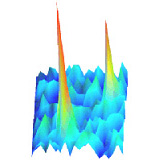We developed a novel methodology to count the number of molecules in a STORM image. That allowed us to address the stoichiometry of adhesion proteins in focal adhesions. It appeared that the stoichiometry in FAK is independent on the force exerted by the cell.
Substrate rigidity modulates traction forces and stoichiometry of cell–matrix adhesions.
Hayri E. Balcioglu, Rolf Harkes, Erik H. J. Danen, and Thomas Schmidt.
In cell–matrix adhesions, integrin receptors and associated proteins provide a dynamic coupling of the extracellular matrix (ECM) to the cytoskeleton. This allows bidirectional transmission of forces between the ECM and the cytoskeleton, which tunes intracellular signaling cascades that control survival, proliferation, differentiation, and motility. The quantitative relationships between recruitment of distinct cell–matrix adhesion proteins and local cellular traction forces are not known. Here, we applied quantitative super-resolution microscopy to cell–matrix adhesions formed on fibronectin-stamped elastomeric pillars and developed an approach to relate the number of talin, vinculin, paxillin, and focal adhesion kinase (FAK) molecules to the local cellular traction force. We find that FAK recruitment does not show an association with traction-force application, whereas a ∼60 pN force increase is associated with the recruitment of one talin, two vinculin, and two paxillin molecules on a substrate with an effective stiffness of 47 kPa. On a substrate with a fourfold lower effective stiffness, the stoichiometry of talin:vinculin:paxillin changes to 2:12:6 for the same ∼60 pN traction force. The relative change in force-related vinculin recruitment indicates a stiffness-dependent switch in vinculin function in cell–matrix adhesions. Our results reveal a substrate-stiffness-dependent modulation of the relationship between cellular traction-force and the molecular stoichiometry of cell–matrix adhesions.

